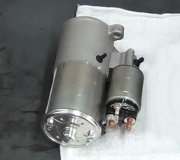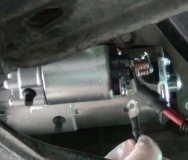Removing a starter or generator from the engine for testing is a very inaccurate way to do it. With no physical load on it, any worn-out starter will test good. It only needs to draw around 30 to 50 amps when free-wheeling. You want to test it for its ability to spin the engine. That will require between 150 and 200 amps. Most failure-to-crank problems occur in the cables and connections. Those are included in the testing when the starter is on the engine.
If that one click you described is a rather loud clunk from the starter solenoid, that further suggests there is a bad connection or one of the cables is corroded away under the insulation. To test for that, the fastest way is to use a digital voltmeter set to the 20-volt scale. Place one probe on a paint-free point on the engine block, and the other probe on the large stud on the starter solenoid, not the terminal bolted to it. That is the terminal the positive battery cable is bolted to. You will find close to 12.6 volts if the battery is good and fully-charged. What is of interest is what that voltage drops to when a helper tries to crank the engine. During cranking, it should stay above a minimum of 9.6 volts. Typically when you have a cable or connection problem, the voltage will drop to less than a volt or two.
If the voltage drops too much, you can get a clue as to whether the problem is in the positive cable or the negative ground cable. Turn on the head lights and watch the brightness. This should work with the interior lights too. If the bad connection is in the negative cable that is bolted to the engine, the lights will stay bright when the voltage at the starter drops. The lights are grounded through the body sheet metal, not the engine block. If the lights go out when trying to crank the engine, the bad connection is in part of the circuit that includes the head lights. That includes both cable connections at the battery, and on some GM models, the entire positive cable and the connection at the starter solenoid. GM likes to use that connection at the starter for a convenient tie point for other circuits. It saves a little wire, but it affects how some of the clues and observations are interpreted.
Sunday, August 20th, 2017 AT 10:39 PM



